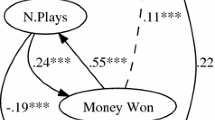Abstract
Relatively little research has been undertaken on the influence of jackpot structural features on electronic gaming machine (EGM) gambling behavior. This study considered two common features of EGM jackpots: progressive (i.e., the jackpot incrementally growing in value as players make additional bets), and deterministic (i.e., a guaranteed jackpot after a fixed number of bets, which is determined in advance and at random). Their joint influences on player betting behavior and the moderating role of jackpot size were investigated in a crossed-design experiment. Using real money, players gambled on a computer simulated EGM with real jackpot prizes of either $500 (i.e., small jackpot) or $25,000 (i.e., large jackpot). The results revealed three important findings. Firstly, players placed the largest bets (20.3 % higher than the average) on large jackpot EGMs that were represented to be deterministic and non-progressive. This finding was supportive of a hypothesized ‘goal-gradient effect’, whereby players might have felt subjectively close to an inevitable payoff for a high-value prize. Secondly, large jackpots that were non-deterministic and progressive also promoted high bet sizes (17.8 % higher than the average), resembling the ‘rollover effect’ demonstrated in lottery betting, whereby players might imagine that their large bets could be later recouped through a big win. Lastly, neither the hypothesized goal-gradient effect nor the rollover effect was evident among players betting on small jackpot machines. These findings suggest that certain high-value jackpot configurations may have intensifying effects on player behavior.



Similar content being viewed by others
Notes
Any money amount reported in this article is measured in Australian currency, unless otherwise stated.
The participant who missed that question was included in the analysis, since excluding the participant didn’t change the substance of the results.
References
Beenstock, M., & Haitovsky, Y. (2001). Lottomania and other anomalies in the market for lotto. Journal of Economic Psychology, 22, 721–722.
Blaszczynski, A., Gainsbury, S., & Karlov, L. (2014). Blue Gum gaming machine: An evaluation of responsible gambling features. Journal of Gambling Studies, 30(3), 697–712.
Brown, J. S. (1948). Gradients of approach and avoidance responses and their relation to level of motivation. Journal of Comparative and Physiological Psychology, 41(6), 450–465.
Browne, M., Langham, E., Rockloff, M. J., Li, E., Donaldson, P., & Goodwin, B. (2014). EGM jackpots and player behavior: An in-venue shadowing study. Journal of Gambling Studies. Advance online publication. doi:10.1007/s10899-014-9485-y.
Cervone, D., Orom, H., Artistico, D., Shadel, W. G., & Kassel, J. D. (2007). Using a knowledge-and-appraisal model of personality architecture to understand consistency and variability in smokers’ self-efficacy appraisals in high-risk situations. Psychology of Addictive Behaviors, 21(1), 44–54.
Easterbrook, J. A. (1959). The effect of emotion on cue utilization and the organization of behavior. Psychological Review, 66(3), 183–201.
Eisenberger, R., & Selbst, M. (1994). Does reward increase or decrease creativity? Journal of Personality and Social Psychology, 66(6), 1116–1127.
Farrell, L., Morgenroth, E., & Walker, I. (1999). A time series analysis of U.K. lottery sales: Long and short run price elasticities. Oxford Bulletin of Economics and Statistics, 61(4), 513–526.
Ferris, J., & Wynne, H. (2001). The Canadian Problem Gambling Index: Final report. Prepared for the Canadian Centre on Substance Abuse.
Friedman, R. S., McCarthy, D. M., Förster, J., & Denzler, M. (2005). Automatic effects of alcohol cues on sexual attraction. Addiction, 100(5), 672–681.
Friedman, R. S., McCarthy, D. M., Pedersen, S. L., & Hicks, J. A. (2009). Alcohol expectancy priming and drinking behavior: The role of compatibility between prime and expectancy content. Psychology of Addictive Behaviors, 23(2), 329–333.
Harrigan, K., Dixon, M., & Brown, D. (2014). Modern multi-line slot machine games: The effect of lines wagered on winners, losers, bonuses, and losses disguised as wins. Journal of Gambling Studies. Advance online publication. doi:10.1007/s10899-013-9436-z.
Higgins, E. T. (1996). Knowledge activation: Accessibility, applicability, and salience. In E. T. Higgins & A. Kruglanski (Eds.), Social psychology: Handbook of basic principles (pp. 133–168). New York: Guilford.
Hull, C. L. (1934). The rats’ speed of locomotion gradient in the approach to food. Journal of Comparative Psychology, 17(3), 393–422.
Johansson, A., Grant, J. E., Kim, S. W., Odlaug, B. L., & Götestam, K. G. (2009). Risk factors for problematic gambling: A critical literature review. Journal of Gambling Studies, 25(1), 67–92.
Johnson, E. E., Hamer, R. M., & Nora, R. M. (1988). The Lie/Bet questionnaire for screening pathological gamblers: A follow-up study. Psychological Reports, 83(3 Part 2), 1219–1224.
Kivetz, R., Urminsky, O., & Zheng, Y. (2006). The goal-gradient hypothesis resurrected: Purchase acceleration, illusionary goal progress, and customer retention. Journal of Marketing Research (JMR), 43(1), 39–58.
Krech, D., & Crutchfield, R. S. (1948). Theory and problems of social psychology. New York: McGraw-Hill.
Millhouse, H., & Delfabbro, P. (2008). Investigating preferences for gaming machine features in problem and non-problem gamblers using a consumer choice methodology. Gambling Research: Journal of the National Association for Gambling Studies (Australia), 20(1), 37–49.
Rockloff, M. J., Donaldson, P., & Browne, M. (2014). Jackpot expiry: An experimental investigation of a new EGM player-protection feature. Journal of Gambling Studies. Advance online publication. doi:10.1007/s10899-014-9472-3.
Rockloff, M. J., Greer, N., & Evans, L. G. (2012). The effect of mere presence on electronic gaming machine gambling. Journal of Gambling Issues, 27, 1–14.
Rockloff, M. J., Greer, N., Fay, C., & Evans, L. G. (2011). Gambling on electronic gaming machines is an escape from negative self reflection. Journal of Gambling Studies, 27(1), 63–72.
Rockloff, M., & Hing, N. (2013). The impact of jackpots on EGM gambling behavior: A review. Journal of Gambling Studies, 29(4), 775–790.
Rogers, P. (1998). The cognitive psychology of lottery gambling: A theoretical review. Journal of Gambling Studies, 14(2), 111–134.
Rogers, P., & Webley, P. (2001). “It could be us!”: Cognitive and social psychological factors in UK National Lottery play. Applied Psychology: An International Review, 50(1), 181–199.
Sharpe, L., Walker, M., Coughlan, M. J., Enersen, K., & Blaszczynski, A. (2005). Structural changes to electronic gaming machines as effective harm minimization strategies for non-problem and problem gamblers. Journal of Gambling Studies, 21(4), 503–520.
Wohl, M. J., Gainsbury, S., Stewart, M. J., & Sztainert, T. (2013). Facilitating responsible gambling: The relative effectiveness of education-based animation and monetary limit setting pop-up messages among electronic gaming machine players. Journal of Gambling Studies, 29(4), 703–717.
Ziolkowski, S. (2014). The world count of gaming machines 2013. Prepared for the Gaming Technologies Association.
Acknowledgments
This research was fully funded by Gambling Research Australia, a partnership between the Commonwealth, State and Territory Governments. A previous version of this paper has been submitted and published as part of a research report commissioned by Gambling Research Australia.
Conflict of interest
No conflicts of interest are declared.
Author information
Authors and Affiliations
Corresponding author
Rights and permissions
About this article
Cite this article
Li, E., Rockloff, M.J., Browne, M. et al. Jackpot Structural Features: Rollover Effect and Goal-Gradient Effect in EGM Gambling. J Gambl Stud 32, 707–720 (2016). https://doi.org/10.1007/s10899-015-9557-7
Published:
Issue Date:
DOI: https://doi.org/10.1007/s10899-015-9557-7




